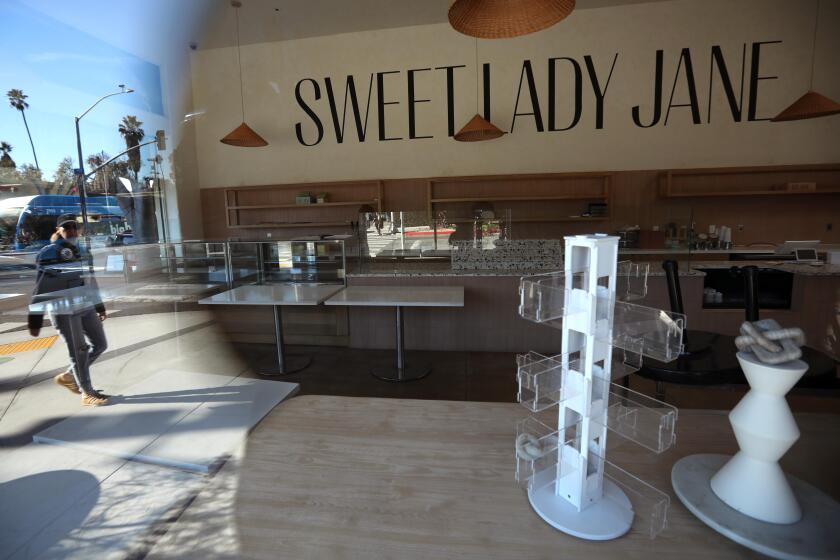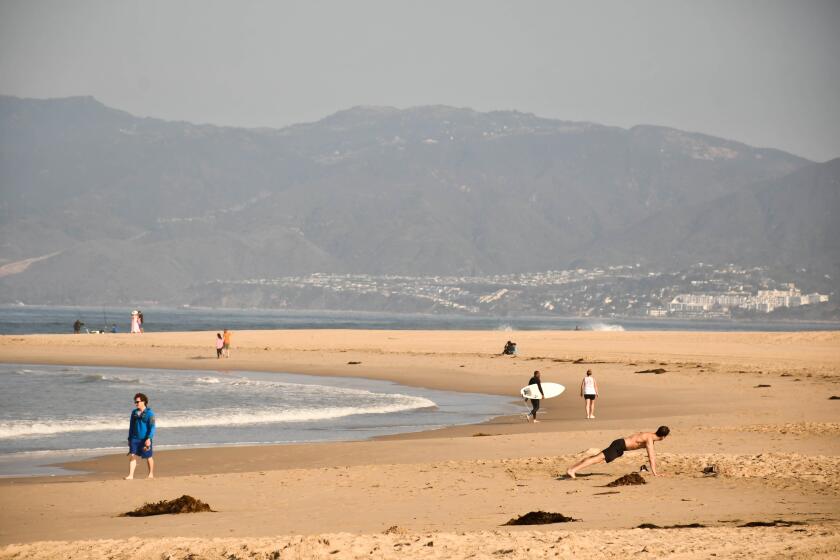Column: In Hermosa, hoping not to be priced out of a beach vacation

Guests of the Sea Sprite Motel in Hermosa Beach say they come back year after year for its beach proximity and affordability.
The Trudgeon family was back again, staying in the beach cottage for the 22nd year in a row, just steps from the sand.
And they were worried.
The Brussels family, customers for almost three decades, was staying in a second-floor suite with an ocean-view balcony above the Hermosa Beach Strand.
And they were worried, too.
“You worry that it won’t be here next year, and when it happens, that’ll be a sad day,” said Marty Brussels, a Phoenix optometrist whose wife, Carmen, is a medical assistant.
The 38-unit, no-frills Sea Sprite Motel, which has offered affordable beach vacations since the 1960s, isn’t going to last forever. Independent mom-and-pop motels and hotels have been vanishing for years on our 1,100-mile coast. They’re gobbled up by chains that raise prices, and bulldozed by developers panning for coastal real estate gold.
This is the 40th anniversary of the Coastal Act, which called for the protection of low-cost accommodations so middle- and lower-income families could enjoy the state’s greatest public resource. Several members of the Coastal Commission have recently said increased access is high on their agenda, but their record in that regard has been inconsistent.
Meanwhile, hotel chains are in the midst of a gold rush. Pacifica, in particular, has been buying and upgrading little inns between San Francisco and San Diego, including six on Moonstone Beach in Cambria. A company press release boasted of the continued coastal expansion and called Pacifica “the largest owner and operator of boutique hotels on the Pacific coast.”
But Susan Jordan, of the California Coastal Protection Network, said those hotels are charging “much higher prices per room than before.”
So whether you’re talking about housing or lodging, the California coast is increasingly the playground and domain of the wealthy. For everyone else, there are day trips, and camp sites, a few nice deals like the cottages at Crystal Cove, and a shrinking number of independent, old-fashioned motels.
Darrell Greenwald’s family has owned the unabashedly modest Sea Sprite since 1966, just feet from the sand in the heart of Hermosa, a bit south of the pier. Greenwald’s mother Thelma once ran the place and told him that if guests had issues with the furnishings, he should just point to the water and emphasize the million-dollar view.
The sea-blue Sprite, a stucco throwback, sits on prime real estate, and Greenwald told me he’s been getting buyout offers “every other day” or so.
For how long?
“The last 10 years,” he said.
He pulled open a filing cabinet drawer in his office to reveal the latest pitches. They’re generally not from hotel companies, he said, but from developers who would probably level what is there and build something else. Maybe condos or restaurants or high-end retail.
Greenwald said there will come a day when he’ll be ready to accept the best offer and retire from what has been a rewarding, but taxing, round-the-clock job.
I asked him why he’s kept rates as low as $140 a room in summer, and what’s holding him back from walking away.
“I could probably double my rates and do fine,” he said. “But you know, the customers helped build this business up, and three generations of families have been coming here. We just don’t want to price them out.”

Mitchell Rowe, a retired firefighter from Folsom, just hit 20 years as a regular. He and his wife, a hairstylist, pay a bit above $200 a night for a two-room suite with a full kitchen and ocean-view balcony.
“It’s one of the last places that’s affordable from Redondo up to Manhattan Beach,” Rowe said. “It’s not luxurious, but it’s relaxed, laid-back. And it’s half what some of the other places charge.”
The extended Trudgeon family always stays in the free-standing three-bedroom cottage, which costs more than $400 a night.
But it sleeps 10, and when friends of friends squeeze in, the price per head is a bargain.
“We’ve had as many as 20 people in here,” said Larry Trudgeon, a retired San Fernando Valley dentist.
He was with daughter Amber, a nurse, and son-in-law James Williams, a building manager, along with other family members who brought bikes, boogie boards, a barbecue, a bean-toss game and a string of lanterns to decorate the porch of the bungalow that becomes home for two weeks every summer.
James proposed to Amber at the lifeguard stand, Trudgeon said, and his grandson Trey caught his first fish on the pier.
But things are changing. Just up the Strand, a Beverly Hills developer is set to build a fancy new hotel, and local institutions like the Mermaid, Good Stuff and The Poop Deck will get flattened to clear the way.
Trudgeon, 70, wonders how long the Sea Sprite can survive.
“This is part of an old-school, nostalgic era, and I think it’s important to preserve it,” he said.
But how?
A 1981 amendment to the Coastal Act prohibited the Coastal Commission from setting room rates, but the agency can and does require developers to provide some lower-cost units in their projects, or elsewhere, or pay fees that can be used to support low-cost units elsewhere. Neither of those things, however, has slowed the loss of affordable options in the face of rampant development.
Reversing the trend won’t be easy, but if someone wanted to drop a wrecking ball on the Sea Sprite and replace it with yet another swanky overpriced hotel, the commission could deny the permit unless the new owner agrees to concessions like the ones I just mentioned.
Last year, commissioners stood strong and rejected up to three hotels on public tidelands in San Diego because the Port District didn’t make a stronger commitment to providing affordable lodging on or near Harbor Island.
That kind of backbone, along with sharper strategies and more consistency, are key going forward, or else beach vacations in California will be out of reach for teachers, cops, construction workers and healthcare workers.
“This commission could do much more than it has,” said Coastal Commissioner Mary Shallenberger. “In the face of developer opposition, I don’t think we have been as strong as we ought to have been.”
At the Sea Sprite, Marty and Carmen Brussels sat on their deck taking in the view on the last day of their escape from the blazing heat of Phoenix. They talked about annual reunions with other longtime regulars and how much they love the cool sea breezes and taking in the sunsets, beach volleyball and evening concerts from their balcony.
If the Sea Sprite goes out of business, Marty said, they’ll never have this again.
Not at this price.
Not on the California coast.
Live Updates -- Follow along with Steve »
steve.lopez@latimes.com | Follow on Twitter: @LATstevelopez
Weigh in at @JerryBrownGov #SaveYourCoast and (916 445-2841) or email governor@governor.ca.gov.
MORE FROM THE ROADTRIP
Why California’s northern coast doesn’t look like Atlantic City
California’s coast: How we come to care and why we sometimes go wrong
More to Read
Sign up for Essential California
The most important California stories and recommendations in your inbox every morning.
You may occasionally receive promotional content from the Los Angeles Times.







